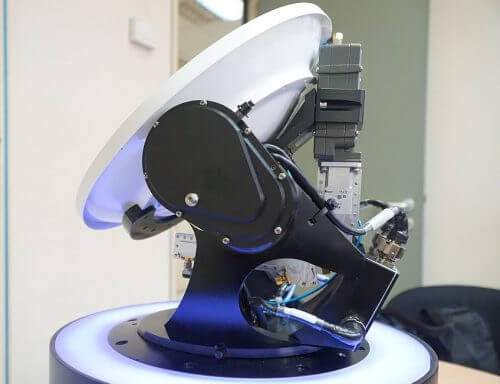The "Bereshit" project reveals what goes on behind the scenes of the Israeli space industry: new technologies create a new market - and a new wave of private entrepreneurship in the space field
The article was first published on the TECHTIME website

Even though the Berashit spacecraft crashed on the moon and did not make a soft landing as planned, this is a huge achievement and an unprecedented event in a number of ways. The spacecraft was developed and launched into space by the SpaceIL association and almost included Israel in the very limited club of countries that have landed a vehicle on the moon, which now includes only the United States, Russia and China. However, unlike the three powers, in Israel the project was carried out entirely by volunteers and private investors through a non-profit association. It is true that she received assistance from the Ministry of Science and the Aerospace Industry, but they joined the project, and did not initiate it.
About 100 million dollars were invested in the development, construction and launch of the spacecraft (which was launched as a secondary payload on a SpaceX launcher), most of which was raised from private donors, led by the philanthropist Maurice Kahn. This is a small amount by any standard compared to other similar projects. The project began as a private initiative of Yariv Bash, Kafir Demari and Yonatan Weintraub, who registered for the Google Lunar XPRIZE competition. Although the competition was canceled in March 2018, SpaceIL announced that it would continue the mission.
Mobileye's lesson
There is no doubt that this is an unprecedented technological and educational achievement, but it represents a much larger and more impressive process: the idea behind the project is based on the emergence of a new category of tiny technologies, such as nanosatellites, which make it possible to carry out space missions that were previously only carried out using very large and very expensive systems. It is no coincidence that the beginning of the project was in the design based on the Cubsat platform of nanosatellites, and that one of the founders of SpaceIL was in the design team of the first Israeli nanosatellite, Inklajn-1, designed by the INSA association in cooperation with the aerospace industry.
Although the final weight of the spacecraft is 585 kg (including the landing probe), this is a tiny weight compared to other systems that landed in space, and it includes many subsystems developed in the tiny satellite division of the Aerospace Industry. The Genesis project is not a commercial project, but it represents a new trend in the Israeli space industry, where small civil entities offer the world market infrastructural solutions based on new miniaturized technologies.
In this way, the Israeli space industry is following in the footsteps of the Israeli automobile industry: until the emergence of the ideas of a smart vehicle, a connected vehicle, and an autonomous vehicle, Israel was considered a country beyond the reach of the global automobile industry. However, from the moment that high-tech became a central component of the global automotive industry, dozens of Israeli companies were established that provide hardware, communication and orientation solutions for vehicles.
The most prominent company is, of course, Mobileye, which was purchased by Intel for $15.3 billion, but Mobileye is only the head of an arrow behind which are racing companies with impressive technologies such as Inviz, Foresight, Altair and hundreds of other companies. Almost every major global car manufacturer is currently looking for Israeli technologies for the automotive field.
Many small, cheap satellites... and made in Israel
If we turn our gaze to the space industry for a moment, we will find that it is only one step behind the automobile industry: the company Sky and Space Global (or SAS), which developed an array of nanosatellites in order to provide satellite communication services, completed a fundraising of approximately 15 million dollars in the allocation A private stock on the Australian Stock Exchange (ASX), where it is traded, and is expected to use the fundraising funds to launch into space, by the middle of the year, a first cluster of 16 nanosatellites, and this from a total array of 200 nanosatellites that are expected to be launched into space during 2020.
SAS was established by veterans of the Israeli space industry, with the aim of developing communication services based on an array of hundreds of nanosatellites from aircraft carriers, capable of providing narrowband communications to many users in the third world, to the transportation market (planes and ships) and to customers in remote areas. The CEO of the company, Meir Moalem, was a pilot in the Air Force during his military service and the commander of space activities in the Air Force. Among the projects he led: the MEDIEX experiment of the first Israeli astronaut, the late Ilan Ramon, and the development of the Techsar and Ofeq satellites.

The chief technologist is Meader Farina who played key roles in the development of the aerospace industry's satellites. He was the deputy mission manager on the Amos 2 satellite, the chief system engineer of the Amos 3 satellite, a professional consultant to the Russian company that built Amos 5, and participated in the development of the Israeli-French satellite VENUS. The company's operations manager is Maya Glickman, who also comes from the satellite division of the Aerospace Industry. She specializes in mission analysis, trajectory planning and operating satellites. She served as a senior engineer in the development of the Amos 3 satellite and in managing the end-of-life process of the Amos 1 satellite. Maya and Midd were involved in the development and launch of Duchifat-1, which was the first Israeli nanosatellite launched into space (2014).
The NSLCOMM company from Kiryat Airport is preparing for the launch of its first satellite, NSLSat-1, which will be carried out during the coming month of June from the new Russian cosmodrome in Vostochny, located in eastern Russia. According to the plan, the satellite will be launched into its heliosynchronous orbit (which maintains a constant angle with respect to the sun) at an altitude of 580 km. This is an important milestone for the company, because the expected launch will give its technology the long-awaited "tested in space" approval, and will allow it to begin a round of new capital raising and the implementation of an ambitious business plan that will culminate in the launch of an array of 120-150 communication nanosatellites by 2023, which will provide Broadband communication services around the world.
At the same time, the market for new technologies is expanding for the new global trend of arrays that include hundreds of tiny and cheap satellites: the company SatixFy from the science park in Rehovot has completed the development of two satellite communication chips. The company plans to launch a series of new products in 2019, which enable the use of multiple beams during communication with LEO satellites, which move at an altitude of 160-2,000 km above the earth's surface and circle the earth every 128 minutes. The chips are designed for use in a flat communication antenna that will allow providing complete terminals at a low price, for mass markets such as IoT and the connected car.

The Orbit company from Netanya is formulating a new strategy that will allow it to be a central supplier of small terminals for the new satellite communication networks, which are expected to enter the market in the coming years and replace the large and outdated communication satellites. At the same time, Gilat Satellite Networks from Petach Tikva is redefining the architecture of its satellite ground stations (VSAT). The changes to the base station include replacing the antennas, replacing the computing system inside the station and building a cloud infrastructure to manage the satellite ground stations. The new stations are not intended to replace the company's current receiving stations, but to prepare it for the developing market of low-flying communication satellites (LEO) which is expected to grow in the next 3-5 years.
These are just the first examples of the underground revolution taking place in the Israeli space industry: new technologies create a new market and a new wave of private entrepreneurship. Of course, there is no substitute for traditional giant satellites such as those that the government or the Ministry of Defense order from the aerospace industry, but the Israeli space industry is quickly discovering the new civilian market, and is imitating the success of the Israeli automobile industry, which grew almost from nothing.

2 תגובות
"The spacecraft was developed and launched into space by the SpaceIL association" developed - true. Sugared?
"Landed in space"?
You must edit the articles on the site.
Definitely interesting